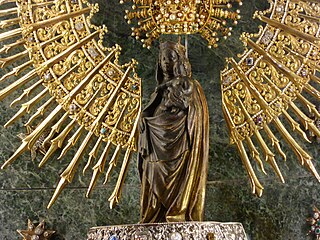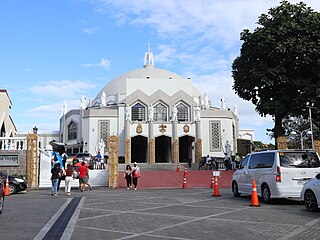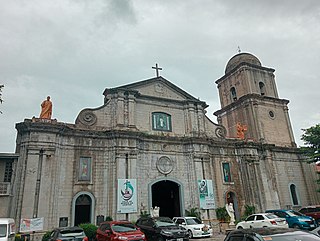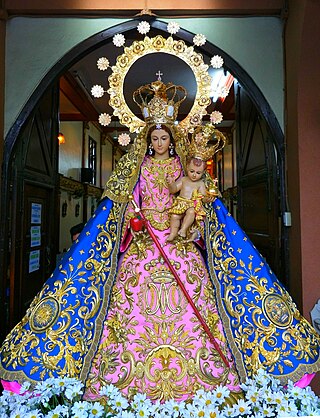
Our Lady of the Pillar is the name given to the Blessed Virgin Mary in the context of the traditional belief that Mary, while living in Jerusalem, supernaturally appeared to the Apostle James the Greater in AD 40 while he was preaching in what is now Spain. Those who adhere to this belief consider this appearance to be the only recorded instance of Mary exhibiting the mystical phenomenon of bilocation. Among Catholics, it is also considered the first Marian apparition, and unique because it happened while Mary was still living on Earth.

The Archdiocese of San Fernando is the archdiocese of the Latin Church of the Catholic Church in Pampanga, Philippines which has territorial jurisdiction over the whole province of Pampanga and Angeles City. The archdiocese is also the metropolitan see of the ecclesiastical province of the same name, which also include three dioceses of its surrounding provinces of Bataan, Zambales, and Tarlac. The cathedral church and seat of the archdiocese is the Metropolitan Cathedral of San Fernando (Pampanga). The Virgin Mary, under the title Virgen de los Remedios, is the principal patroness.

The Diocese of Antipolo is a Latin Church ecclesiastical territory or diocese of the Catholic Church in the Philippines that comprises the Province of Rizal and the city of Marikina in Metro Manila.

Immaculate Conception Cathedral, commonly known as Pasig Cathedral, is a Roman Catholic church located in Plaza Rizal, Barangay Malinao, Pasig in Metro Manila, Philippines. It is the mother church, and serves as the episcopal seat of the Bishop of Pasig and is one of the oldest structures in the city.

The Cathedral Parish of Saint Andrew, also known as the Diocesan Shrine of Nuestra Señora del Buen Suceso and commonly known as Parañaque Cathedral, is one of the oldest Roman Catholic churches in the Philippines, located in Parañaque City, Metro Manila. Established on May 11, 1580 by the Spanish Augustinians, it is, at present, the seat of the Diocese of Parañaque, which comprises the cities of Parañaque, Las Piñas, and Muntinlupa.

The Our Lady of Guidance is a title of the Blessed Virgin Mary associated with a 16th-century Marian image depicted as the Immaculate Conception and widely venerated by Filipinos. The wooden Black Madonna is considered the oldest extant Marian statue in the Philippines. Locally venerated as patroness of navigators and travelers, the image is enshrined at the Ermita Church in the city of Manila.

Our Lady of Peace and Good Voyage, also known as Our Lady of Antipolo and the Virgin of Antipolo, is a seventeenth-century Roman Catholic wooden image of the Blessed Virgin Mary as venerated in the Philippines. This Black Madonna is enshrined in Antipolo Cathedral in the Sierra Madre mountains east of Metro Manila.

Our Lady of the Most Holy Rosary – La Naval de Manila is a venerated title of the Blessed Virgin Mary associated with the same image in the Philippines. Pious believers believe that the Virgin's intercession under this title helped to defeat the invading forces of the Protestant Dutch Republic during the Battles of La Naval de Manila in 1646.

The Minor Basilica and Diocesan Shrine of Our Lady of Charity, also known as Santa Monica Parish Church and Agoo Basilica, is a Roman Catholic minor basilica in Agoo, La Union, Philippines. The shrine is dedicated to the Blessed Virgin Mary under the venerated title of Our Lady of Charity.

Our Lady of the Good Event of Parañaque (Spanish: Nuestra Señora del Buen Suceso de Parañaque; Filipino: Ina ng Mabuting Pangyayari ng Parañaque is the name of a statue of the Madonna and Child enshrined in St. Andrew's Cathedral in Parañaque, Philippines. The original Spanish name is often incorrectly rendered in English as Our Lady of Good Success due to the superficial similarity between the Spanish word "suceso" and the English false friend "success."

The Diocesan Shrine and Parish of Our Lady of the Pillar, commonly known as Imus Cathedral, is a Roman Catholic cathedral church in the city of Imus, in the province of Cavite, Philippines. The church serves as the seat of the bishop of the Diocese of Imus, the diocese that has jurisdiction over the entire Civil Province of Cavite.

The Diocesan Shrine and Parish of Our Lady of Light, commonly known as Cainta Church, is a Roman Catholic parish church located along Andres Bonifacio Avenue in Barangay San Andres, Cainta, Rizal, in the Philippines. The church also operates a neighboring school, Cainta Catholic College. From its time of erection as a parish in 1760 until 1983, it belonged to the Archdiocese of Manila. It was placed under the newly created Diocese of Antipolo in 1983, which is now headed by Ruperto C. Santos. It belongs to the Vicariate of Our Lady of Light.

Our Lady of the Pillar of Imus is a Roman Catholic Marian title of the Blessed Virgin Mary and venerated Marian image of the Madonna and Child atop of a pillar. The town of Imus in the province of Cavite and the Diocese of Imus, considers her as its patroness.

Santa Elena is a barangay of Marikina, Philippines. According to the 2010 census, it has a population of 6,954 people. Bordered by San Roque, Jesus Dela Peña, and Santo Niño, Sta. Elena is said to be one of the first towns established by the Augustinians in what was known as the Marikina Valley and home for the heritage sites such as the Our Lady of the Abandoned Parish and the Kapitan Moy Residence.

The Archdiocesan Shrine of the Blessed Sacrament, also known as the Our Lady of the Pillar Church or simply Santa Cruz Parish, is a Mission Revival Roman Catholic parish church in the district of Santa Cruz, Manila, Philippines. It is under the jurisdiction of the Archdiocese of Manila. The church was built when the arrabal (suburb) of Santa Cruz was established by the Jesuits in the early 17th century. The church had undergone many repairs and reconstruction, with the last reconstruction done in the 1950s.

The International Shrine of Our Lady of Peace and Good Voyage, commonly known as Antipolo Cathedral and alternatively known as the Immaculate Conception Parish, is a Roman Catholic cathedral in Antipolo, Philippines. It enshrines a venerated Black Madonna image of the Blessed Virgin Mary under the title of Our Lady of Peace and Good Voyage, and serves as the seat of the Bishop of Antipolo.

Our Lady of Aránzazu and is a Roman Catholic title of the Blessed Virgin Mary.

Our Lady of Consolation or Mary, Comforter of the Afflicted is a title of the Blessed Virgin Mary venerated in the Catholic Church.

The National Shrine and Parish of Our Lady of Mercy is a Roman Catholic church under the Diocese of Novaliches in the Philippines. It is the oldest parish in the diocese, established in 1856 by the Augustinian missionaries from Spain.






























